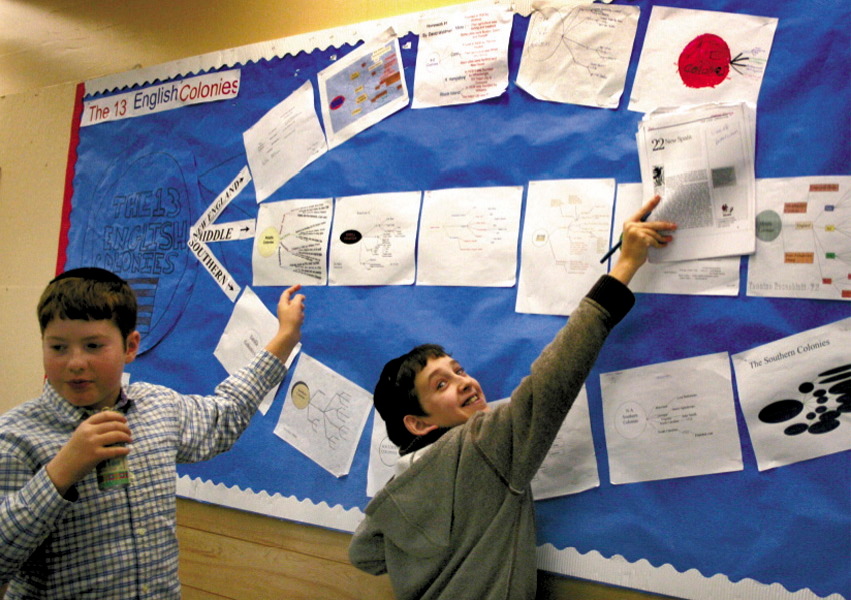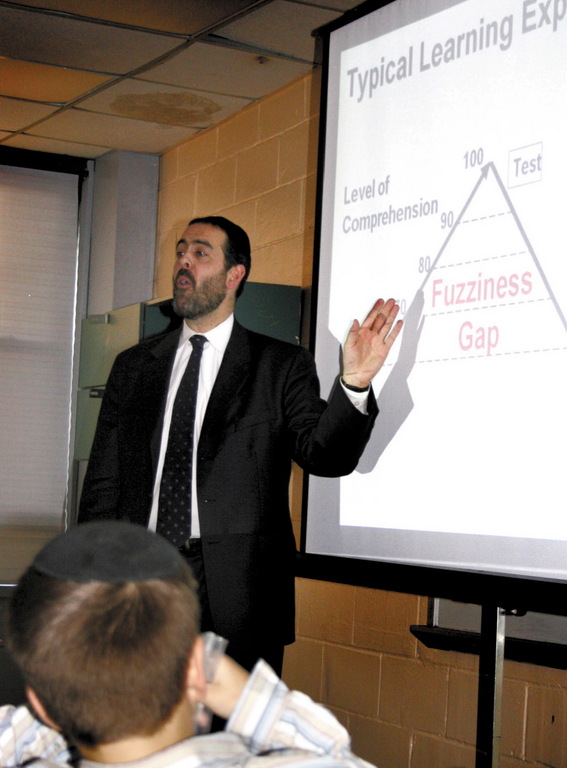Educational model stresses clarity
Yeshiva of South Shore to be among first Goldhar-certified schools
BY AMY GOLDSTEIN
Issue of Jan. 19, 2007
Arthur Shield’s seventh grade social studies class at the Yeshiva of South Shore is learning to review the concepts of diffusion. In 14 seconds. Rabbi Avraham Goldhar of Passaic, N.J., asks the students to fill in the blanks.
“Diffusion is the movement of particles through air from high concentration to ...” “Low,” the students respond together. “It happens through the cell membrane or ...,” he said. “Outside the cell,” they respond. “Is energy required?” he asked. “No,” they answered.
Rabbi Goldhar’s test project is changing the learning environment of the Yeshiva of South Shore. Known as the Goldhar program, South Shore is one of the first schools in the country expected to be certified as a proficient Goldhar school. The elementary school’s sixth through eighth graders find they better understand material both in class and as they review it before exams. The result? Better grades with less study time.
Goldhar first became involved in the learn-it-quick-but-remember-it-well methodology about 16 years ago, when he wrote background crash courses in Limudei Kodesh subjects to help adults who weren’t necessarily religious their entire lives catch up quickly. He once had similar trouble.
Five years ago, he was asked to apply what he had taught in crash courses as a study skill. He said he didn’t want to, but he did it anyway. The test? A seventh-grade biology class. Students’ grades improved by 20 to 50 percent while studying time was reduced by 50 to 80 percent.
To date Rabbi Goldhar has taught thousands of students his note-taking method, where students learn to process information so they break down and simplify what they learn while they’re taking notes. The buy-in for them is the decreased study time. The method doesn’t discriminate against weaker students. “It’s reaching every student in the class,” said Rabbi Shmuel Schwebel, general studies principal of the Yeshiva of South Shore. “They’re jumping on board in every way to get involved. ... Success breeds success [in other subjects].”
The method is uniform for both Hebrew and English subjects because knowing what to write down in a notebook is a skill set of the mind rather than of the material. The skill set shuns writing in complete sentences.
“A sentence is a training wheel for the mind,” Rabbi Goldhar said. “They don’t need to write down every word because their mind is very capable of processing it, and it’s showing all students they can have much greater confidence in their thinking skills.” Instead, it favors writing in spokes. Each spoke has a brief phrase that triggers the mind so the student recalls what he or she has learned. The spoke system helps each student make sense from what a teacher says in class.
“Teachers can be clear in articulating things, but that doesn’t mean every kid is walking away with that clarity in hand,” Rabbi Goldhar said. The teachers at South Shore appreciate the method. Shield, who has used the Goldhar method in his classes since he learned it in the spring, said he has improved his use of the blackboard.
“When I utilize the board with the Goldhar method it’s usually done toward the end of the period. It’s almost like a culminating thing — let’s bring it all together — the kids leave classroom having all the same information.”
Visual clues are key.
“Instead of having to study by reading horizontally they see it vertically with the spokes and baby spokes they create which come off each of the main spokes,” Shield said. “The kids take to it right away.”
Shield, who taught public school students for 34 years before teaching at Yeshiva of South Shore, said he doesn’t give out high grades unless the students earn them. But he has seen positive results quickly. On a recent test, 11 out of 21 students in one of his seventh-grade classes scored 90 or above — even before they had received official training from Rabbi Goldhar.
The administration at South Shore feel the students succeed because they control the material.
“The students in class have a model that’s helping them organize and file, and they’re being able to retain the information so when they walk up to the test they’re up to mastery,” Rabbi Schwebel said. “It takes away the fear factor. It takes away the cloud over their head. The night before a test doesn’t become a nightmare.” With the Goldhar system, the hallway becomes a classroom.
Rabbi Goldhar works at the Yeshiva of South Shore for several hours every Tuesday and the students are eager to see him. On a recent Tuesday, eighth grader Aaron Katan saw Rabbi Goldhar and ran up to him, shouting, “Rabbi Goldhar! Rabbi Goldhar!” He showed him how he used the spoke technique to learn a blatt of Gemara. The ownership of the learning process turns every student into a cognizant one.
“The weakest kid [in another Goldhar school in Philadelphia] comes home, he circles his books, he has a way of conquering and seeing real success,” Rabbi Goldhar said. “That makes school much more exciting for him.”
Rabbi Goldhar feels that the goal of setting the bar high can change the school. “My passion is to show we can generate dramatic results in education, and the best way to make it apparent is if you can do it schoolwide — with a variety of students and teachers buying into it,” he said. “It changes the learning culture with very concrete results.”
To learn more about the Goldhar program go to www.goldhar.com.
Yeshiva of South Shore students use Rabbi Goldhar’s methods to help remember the original 13 English colonies. By using visual clues these students find it 10 times easier to learn.

 46.0°,
Light Drizzle
46.0°,
Light Drizzle 







